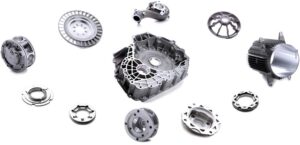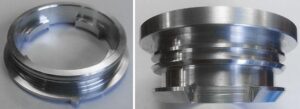Investment Casting
Selecting Investment Casting Materials
Investment casting is a single-use mold process ideal for making complex metal parts that are difficult or expensive to machine. As the mold is broken apart to release the metal casting, features like undercuts and overhangs are possible. In addition, draft angles are unnecessary, and there are no parting lines.
Most metals can be used in investment casting, although some need special considerations. This blog reviews the most widely used investment casting materials and highlights their properties and applications.
Most Common Types of Steel
Low Alloy Steels
This family of steel is composed of iron, carbon, and little else. With less than 12% other alloying elements in their makeup, they lack the exceptional corrosion resistance of stainless steel but are also less expensive.
As-cast, yield strength ranges from 45,000 to 75,000 PSI. Elongation is up to 25%, showing these metals have good ductility. Strength and hardness are increased by heat treatment. In molten form, they flow and cast well. Common applications for low alloy steel investment castings include gears, crankshafts, and hydraulic cylinders.
Martensitic Stainless Steel
“Martensite” refers to the crystalline form this alloy takes as it cools. A high level of chromium, combined with low nickel content, leads to a “body-centered cubic” structure. Martensitic stainless steel is strong and hard but has low ductility and can be magnetized. Corrosion and wear resistance are very good, so this type of stainless is often used to manufacture pumps and valve bodies. Other applications include knives, tools, and medical devices.
Austenitic Stainless Steel
Austenitic stainless steel contains high levels of chromium and nickel, with some grades also containing molybdenum. The structure is “face-centered cubic,” which results in higher ductility than the martensitic grades but slightly lower hardness and strength. Austenitic stainless steels still have good corrosion resistance but are not magnetic. They are, however, weldable.
Because austenitic stainless steels have an attractive finish, they are often used in architectural and decorative applications. They are also used extensively in the automotive, aerospace, and medical industries.
Ferritic Stainless Steel
Used less often than austenitic and martensitic stainless, ferritic stainless steel has an iron-chromium composition with zero nickel. The structure is body-centered, like the martensitic grades, and the alloy is magnetic and corrosion-resistant. It has good ductility but low hardness. Common applications for ferritic stainless steel investment castings include piping, heat exchanges, HVAC system components, and more.
Duplex Stainless Steel
Duplex stainless steel is a recently developed form of stainless steel with characteristics of ferritic and austenitic grades. Comprising a high quantity of chromium with a small amount of nickel, duplex stainless steel offers high strength at a relatively low price. Corrosion resistance is good, and resistance to stress corrosion cracking is superior to that of austenitic grades.
Applications for duplex stainless steel investment castings include pressure vessels and storage tanks for brewing and chemical processing.
Copper-Based Alloys
Bronze and brass are both copper-based alloys, which illustrates the wide variety of compositions available. Bronze is an alloy of copper and tin, aluminum, manganese, and other elements. Brass is made by alloying copper with zinc. Another type is copper alloyed with nickel.
Copper-based alloys have lower melting points than stainless or carbon steel and lower strength and hardness. They offer good corrosion resistance and ductility, as well as high thermal and electrical conductivity. Common uses include marine applications and electrical devices.
Tool Steel
Tool steels are hard and typically abrasion-resistant. Depending on the composition, they may provide good shock or wear resistance and high-temperature strength. These characteristics make them useful for molds and dies, knives, cutting tools, and punching and forming tools. Carbon and alloy steels meeting this description are therefore referred to as “tool steels.”
Factors to Consider When Selecting a Material
The material chosen for investment casting must have the properties needed for the intended application. While factors like cost and castability are always considered, they only become relevant after compiling a shortlist of casting materials ideal for the intended application. Important properties affecting performance in the application are discussed in the following sections.
Mechanical Properties
In parts that will be placed in tension or under load, yield strength is almost always the primary consideration. This is the load at which the metal takes a permanent deformation and will not recover elastically.
The difference between yield strength and ultimate tensile strength provides a measure of ductility. The bigger the difference, the higher the ductility and more ductile materials are desired if they will be bent during processing.
Hardness is also important when a surface will see heavy loads or abrasive wear. The hardness of some steels can be raised by heat treatment. Hard materials tend to be brittle, but when hard and ductile, they are considered tough.
Weldability can be another important mechanical consideration for parts made by investment casting. Some alloys, such as low carbon steels, are easily welded, but others, like martensitic stainless, pose challenges.
Corrosion Resistance
All alloys form an oxide layer on the surface, especially in the presence of moisture. With steel, this can be a problem as the oxides form rust that flakes away from the body of the metal. Options for delaying this are to coat or choose a corrosion-resistant metal.
The high chromium content of stainless steel tends to prevent corrosion, allowing its use in damp or humid environments without coating. The ferritic and martensitic grades offer particularly good corrosion resistance and are often selected for marine applications.
Weight

Weight is often part of the selection criteria for investment cast parts intended for use in transportation applications. Steel and stainless steel alloys are dense, which can make parts cast in these heavy. Choosing less dense alloys, like aluminum, magnesium, titanium, zinc, and copper, can result in lower mass.
It is also important to consider the loads the part will be subjected to. Sometimes, choosing a more dense alloy can result in less being needed due to its higher strength per pound. Aluminum of the 6xxx and 7xxx series can have a higher specific strength than some grades of steel.
Temperature Resistance
With some alloys, strength declines quickly at higher temperatures. Others suffer accelerated corrosion. If the application will subject an investment cast part to high temperatures, this should be part of the selection criteria.
High temperatures are common in many chemical processing and power generation applications. In particular, parts used in gas turbines can be exposed to very high temperatures. Alloys ideal for such applications include nickel-based alloys, cobalt-based alloys, and stainless steel alloys.
Learn More From AmTech OEM
Investment casting is an exceptional manufacturing method for producing complex, high-quality components. It allows for component consolidation, which reduces assembly work. Investment casting can hold tight tolerances and reproduce fine details that make secondary machining unnecessary.
If you’re looking for an investment casting partner, look no further than AmTech. We’re an OEM-approved Tier 1 & Tier II manufacturer with three decades of casting and machining experience.
Visit our blog for more information about investment casting, or contact us today to learn more about our capabilities or to request a quote.
